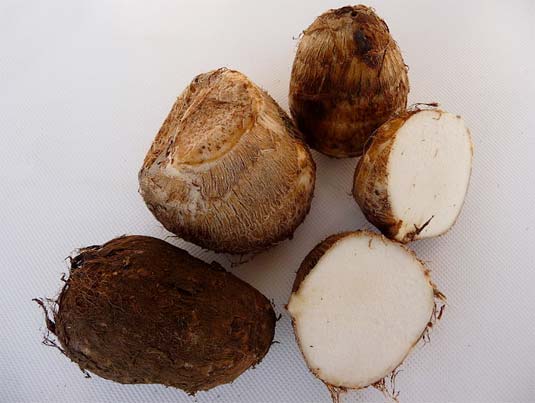Taro Root (Albi) Plaster for Breaks, Splinters, and Minor Skin Infections

Albi Plaster: Natural Pain Remedy
How to use taro root plaster (albi plaster) for easing pain and facilitating healing with bone breaks, joint sprains and strains, arthritic joints, splinters, and minor skin infections. Make it using ingredients from your local farmers market or grocery store.
Image: Taro Root
Albi plaster was introduced to me by my teacher, Dr. Thomas Duckworth D.K.M., L.Ac., in my second year of studies. Once I had the recipe, I found it came in handy quickly. I learned from first hand experience the accelerated healing effects. And more importantly to me, the pain relieving effects of a simple taro root plaster surprised me. It is simple to make and apply. And taro root is quite accessible and inexpensive.
Before being licensed in acupuncture, I earned my living solely as a professional massage therapist. A sprain or strain to a muscle or joint could be an incredible impact to my pocket book. Not to mention causing inconvenient discomfort to the chronic pain sufferers whom I treat for whatever time off I needed to recover. I had, over the thirteen years, been diligent in personal care to avoid over-use injuries. However, one day, simply walking through the same door that I had walked through probably thousands of times prior, I banged my wrist on the door jam – hard! So hard in fact, that I thought I might have broken it. Turned out to be a bone bruise. The pain was making it hard to work. I, of course, got a meridian therapy session as soon as possible. Until then, I put tofu on it while I made the taro root plaster.
Tofu helps cool inflammation without over-cooling the tissues. It is quite effective in those first moments of injury. A tofu plaster can be made, but usually I just slice a piece off and lay it on my boo boo. In this case I secured the tofu slice in place with a gauze wrap while I set to work making the taro root plaster. Once made, I secured the taro root plaster in place with gauze wrap. Shortly after the first application the pain diminished by about seventy-five percent. I was able to use it for work (with albi in place) after about thirty-six hours. In a week, I was pain free and had full use of my hand and wrist. I no longer felt the need for the plaster. Believe me, I was amazed and delighted. I really hate to work with pain.
To make taro root plaster:
45% grated fresh taro root
5% grated fresh ginger (or dry ground powder ginger)
5% grated bok choi (optional)
45% all purpose wheat flour
enough water to make into a bread-like dough
Although not in the original recipe, I have added calcium-rich bok choi in the same measurement and at the same time as the ginger. There is some controversy over the calcium oxalate which is present in the taro root. Calcium oxalate, when it is ingested, may cause kidney stones and joint pain. I’ve seen articles linking calcium oxalate to bone loss. As the taro is not being ingested, I don’t feel it would cause any of these problems applied topically. However, to be on the safe side, I follow the example of those who suggest calcium should be added to the mix to bind with the calcium oxalate. If not adding the bok choi, make the flour a full 50%.
Mix the ingredients together adding enough water to make a bread-like dough. I add water a teaspoon at a time, as I would for pie crust preparation. The weather of the day will affect how much water is needed. Dry day equals more water. I use my hands to mix the ingredients as I am a firm believer that our hands impart healing energy into whatever our project. You can make a little or a lot. The leftover can be placed into the refrigerator and kept for several days. If it begins to have a sour smell, it has outlived its shelf life and should not be used.
To apply:
Take a ball of the dough and flatten to approximately one quarter to one half inch. It should cover the area in need of healing and an inch or two beyond. Secure in place with bandage. Leave in place for four hours for the first application. After that you will keep albi in place twenty-four /seven, changing the plaster every eight hours. If the plaster becomes very wet and sloppy, change the plaster. It is removing excess liquid. If the plaster becomes very dry and gravelly, replace the plaster. It has removed the inflammatory heat. Should the skin become irritated by the plaster, rub the clean skin with dark sesame oil prior to albi application. It is not uncommon to have little bumps on the surface of the skin after a few days of application. Albi brings the toxins out through the skin.
Warning:
Albi is very powerful at removing foreign matter from the body. Do not place over areas that have replacement parts, such as hip replacement, or metal pins. The taro root plaster will make an effort to draw these foreign objects out of the body. That will cause pain. This shows how powerful its drawing nature is. It is quite successful at drawing out splinters or infected matter. In other countries, albi plaster is used in the treatment of cancer to shrink tumors.
Taro root plaster has also been used on swollen, hot, and painful arthritic joints. And recently, a patient of mine had been diagnosed with a torn meniscus of the medial knee. He opted out of surgery for now. Along with meridian therapy, he used albi plaster as directed for several months. He may have moments when the knee reminds him of the tear, but he no longer has chronic pain and is back to golfing and yard maintenance.
There are conditions where albi can exacerbate the condition. In my own personal experience, I had a very tight calcaneal (achilles) tendon that caused ankle and foot pain. By wearing the albi along the calcaneal tendon, the pain grew. So I stopped wearing albi and started stretching and hydrating to facilitate the tendon’s flexibility. I have used albi on my arthritic ankle since to draw out the edema. But to rely on it to fix a problem of flexibility was lazy on my part and a valuable lesson.
In the case of bone breaks, it is important to get a proper diagnosis. To put albi on a fracture that has not been properly set would cause the body to heal in a misaligned manner. If a compound fracture has been surgically altered and has hardware, albi plaster is not recommended. For a broken toe that is going to be taped to the next toe, albi is great! Put it on the whole toe. Secure with gauze wrap and secure to the next toe. It will relieve the pain and facilitate healing. For appendage breaks that have removable flexible casts, albi is excellent. Put it on under the cast. I often wonder if the modern day cast wasn’t inspired by a cast of albi plaster like the modern day syringe was inspired by acupuncture needles. For rib breaks, put albi on the area of the break prior to wrapping the torso.
In the case of skin infections, my teacher, Thomas Duckworth, was introduced to albi plaster by his teacher, Nakazano Sensei, due to an infected finger. The allopaths wanted to amputate the finger. Sensei suggested albi plaster. Dr. Duckworth still has that finger intact and infection free.
Having albi plaster as a part of your family first-aid repertoire is a must in my book. While a little time consuming, it is easy and quickly relieves the pain. And it is quite economical. There are mixes available on the internet shopping sites. So you could keep the dry powder around for emergencies. But if you are out, it is nice to know that you can obtain the ingredients to this valuable healing aid with a trip to your local grocery store or farmer’s market.

